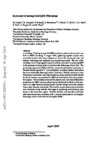Summary of strong-field QED Workshop
| dc.contributor.author | Altarelli, M | |
| dc.contributor.author | Assmann, R | |
| dc.contributor.author | Burkart, F | |
| dc.contributor.author | Heinemann, B | |
| dc.contributor.author | Heinzl, Thomas | |
| dc.contributor.author | Koffas, T | |
| dc.contributor.author | Maier, AR | |
| dc.contributor.author | Reis, D | |
| dc.contributor.author | Ringwald, A | |
| dc.contributor.author | Wing, M | |
| dc.date.accessioned | 2021-05-18T16:06:27Z | |
| dc.date.available | 2021-05-18T16:06:27Z | |
| dc.date.issued | 2019-04-30 | |
| dc.identifier.uri | http://hdl.handle.net/10026.1/17151 | |
| dc.description | 24 pages, 9 figures. Summary by session convenors of workshop on "Probing strong-field QED in electron-photon interactions" in DESY, Hamburg, August 2018 | |
| dc.description.abstract |
A workshop, "Probing strong-field QED in electron--photon interactions", was held in DESY, Hamburg in August 2018, gathering together experts from around the world in this area of physics as well as the accelerator, laser and detector technology that underpins any planned experiment. The aim of the workshop was to bring together experts and those interested in measuring QED in the presence of strong fields at and above the Schwinger critical field. The pioneering experiment, E144 at SLAC, measured multi-photon absorption in Compton scattering and $e^+e^-$ pair production in electron--photon interactions but never reached the Schwinger critical field value. With the advances in laser technology, in particular, new experiments are being considered which should be able to measure non-perturbative QED and its transition from the perturbative regime. This workshop reviewed the physics case and current theoretical predictions for QED and even effects beyond the Standard Model in the interaction of a high-intensity electron bunch with the strong field of the photons from a high-intensity laser bunch. The world's various electron beam facilities were reviewed, along with the challenges of producing and delivering laser beams to the interaction region. Possible facilities and sites that could host such experiments were presented, with a view to experimentally realising the Schwinger critical field in the lab during the 2020s. | |
| dc.language.iso | en | |
| dc.subject | hep-ex | |
| dc.subject | hep-ex | |
| dc.subject | hep-ph | |
| dc.subject | physics.plasm-ph | |
| dc.title | Summary of strong-field QED Workshop | |
| dc.type | journal-article | |
| plymouth.author-url | http://arxiv.org/abs/1905.00059v1 | |
| plymouth.organisational-group | /Plymouth | |
| plymouth.organisational-group | /Plymouth/Faculty of Science and Engineering | |
| plymouth.organisational-group | /Plymouth/REF 2021 Researchers by UoA | |
| plymouth.organisational-group | /Plymouth/REF 2021 Researchers by UoA/EXTENDED UoA 10 - Mathematical Sciences | |
| plymouth.organisational-group | /Plymouth/REF 2021 Researchers by UoA/UoA10 Mathematical Sciences | |
| plymouth.organisational-group | /Plymouth/Users by role | |
| plymouth.organisational-group | /Plymouth/Users by role/Academics | |
| dc.rights.embargoperiod | Not known | |
| rioxxterms.licenseref.uri | http://www.rioxx.net/licenses/all-rights-reserved | |
| rioxxterms.type | Journal Article/Review |


